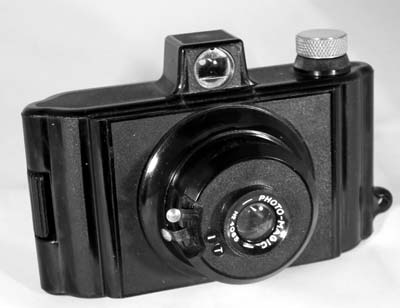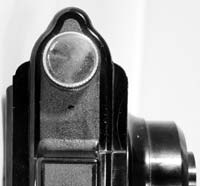Artima Photo-Magic
Specification

| Manufacturer | : | Artima |
|---|---|---|
| Produced | : | 1950 |
| Classification | : | Medium Format |
| Body Type | : | Compact |
| Construction | : | Bakelite |
| Film Type | : | 127 |
| Film Width | : | 46mm |
| ImageSize | : | 1⅝ x 2½ |
| No. of Images | : | 8 |
| Lens Type | : | Meniscus |
| Focus Type | : | Fixed |
| Focal Length | : | 60mm |
| Focal Range | : | 5¾ft - inf. |
| Aperture Type | : | Fixed |
| Aperture | : | f/13 |
| Shutter Type | : | Guillotine type |
| Shutter Speeds | : | I*(1/60s) |
| Size (w x h x d) | : | 130 x 78 x 72 mm |
| Weight | : | 200g |
| * Measured on this camera | ||
Art Deco Credentials
![]()
![]()
Acceptable: Modest and restricted
- Body shape designed in the main Art Deco period.
- Polished and patterned Bakelite
- Curvilinear body design
- Stepped body design
- Chrome Film advance knob
- Chrome embellishments to viewfinder
Description

The Artima Photo-Magic is a viewfinder camera made almost entirely of Bakelite. The Art Deco style is shown by the stepped, curvilinear shape of the Bakelite body. The design first appeared in 1935 and was produced in France. The French versions of this camera are identified by the letters 'P'(Pose) and 'I'(Instant) adjacent to the shutter release. The later (1950) British models had 'T'(Timed) and 'I'(Instant) adjacent to the shutter release. They were distributed by Boumsell who also sold the camera under their name. It was also manufactured in Bordeaux red.
It is very simple design with a meniscus lens which is marked Photo-Magic and No 4065. The same markings are seen on all versions of this camera. It has a simple time and instant shutter. The time function operates as 'Bulb'.
How to Use
This camera takes 127 film which is still available from select outlets - search for 'Rera Pan 100-127' which is a black & white film. For those photographers in the UK, try Nick & Trick photographic services. If you want to use a particular type of film which is not available commercially, then you can cut your own 127 film from any 120 film. See my page on 'How to cut 127 film from 120 film'.
This camera supports Timed mode and Instant with a speed of about 60 sec. It has a single aperture settings of f/13. With a shutter speed of only 1/60 sec, make sure you brace the camera against your body or something solid and press the shutter smoothly to avoid camera shake. Don't forget to cover the red window with black electrical tape except when advancing the film in low light. Modern film is sensitive to red light.
If you don't want to bother with an exposure meter, follow the guide shown. It is based on the 'Sunny 16' rule. Film is so forgiving and will produce acceptable results even when over-exposed by 2 or 3 stops or under-exposed by 1 stop.
The table shown assumes the shutter speed is about 1/60s.
The table also assumes that the sun is at least 30 degrees above the horizon - that's 10am - 5pm on a summers day in the UK.
Remember that the exposure guide in the manual may not be helpful as it is based on the use of old film with a low ISO value.
So, on a nice sunny day, it's simplicity itself. Just load film and snap away.
Using ISO 100/125 film - shutter speed 1/60s
| Weather Conditions | Shadow Detail | Aperture | Exposure |
|---|---|---|---|
 Sunny SunnySnow/Sand | Dark with sharp edges | f/13 | +2½ Stops Overexposed Acceptable |
 Sunny Sunny | Distinct | f/13 | +1½ Stops Overexposed Acceptable |
 Slight Overcast Slight Overcast | Soft around edges | f/13 | +½ Stop Overexposed Acceptable |
 Overcast Overcast | Barely visible | f/13 | -½ Stop Underexposed Acceptable |
 Heavy Overcast Heavy Overcast | None | f/13 | -1½ Stops Underexposed Not Acceptable |
 Open Shade Open Shade/Sunset | None | f/13 | -2½ Stops Underexposed Not Acceptable |